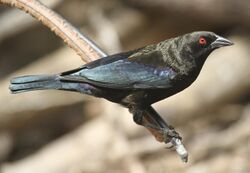Biology:Bronzed cowbird
| Bronzed cowbird | |
|---|---|

| |
| Scientific classification | |
| Domain: | Eukaryota |
| Kingdom: | Animalia |
| Phylum: | Chordata |
| Class: | Aves |
| Order: | Passeriformes |
| Family: | Icteridae |
| Genus: | Molothrus |
| Species: | M. aeneus
|
| Binomial name | |
| Molothrus aeneus (Wagler, 1829)
| |

| |
| Range of M. aeneus Breeding range Year round range
| |
The bronzed cowbird (Molothrus aeneus), once known as the red-eyed cowbird, is a small icterid.
They breed from the U.S. states of California , Arizona, New Mexico, Texas , and Louisiana south through Central America to Panama. They tend to be found in farmland, brush, and feedlots. Outside the breeding season, they are found in very open habitats, and roost in thick woods. These birds forage in open areas, often near cattle in pastures. Their diet mostly consists of seeds and insects, along with snails during breeding season for a calcium source.[2] There are three subspecies:[3]
- M. a. loyei Parkes & Blake, 1965 is found in the southwestern United States and northwestern Mexico.
- M. a. assimilis (Nelson, 1900) is found in southwestern Mexico.
- M. a. aeneus (Wagler, 1829), the nominate subspecies, is found in South Texas and from eastern Mexico to central Panama
The bronze-brown cowbird, which is restricted to the Caribbean coast of Colombia, was formerly considered to be an isolated population of this species.[3]
The male bronzed cowbird is 20 cm (7.9 in) long and weighs 68 g (2.4 oz), with green-bronze, gloss-black plumage. His eyes are red in breeding season and brown otherwise. The female is 18.5 cm (7.3 in) long and weighs 56 g (2.0 oz). She is a dull black with a brown underbelly, and has brown eyes. Young birds have coloring similar to the females, with the exception of grey feather fringes.[4]
Like all cowbirds, this bird is an obligate brood parasite; it lays its eggs in the nests of other birds. The young cowbird is fed by the host parents at the expense of their own young. Hosts include Prevost's ground-sparrows and white-naped brush finches. They develop rapidly, leaving the nest after 10–12 days.
References
- ↑ BirdLife International (2017). "Molothrus aeneus". IUCN Red List of Threatened Species 2017: e.T22732035A119468342. doi:10.2305/IUCN.UK.2017-3.RLTS.T22732035A119468342.en. https://www.iucnredlist.org/species/22732035/119468342. Retrieved 19 November 2021.
- ↑ "Bronzed Cowbird". Audubon. 13 November 2014. https://www.audubon.org/field-guide/bird/bronzed-cowbird.
- ↑ 3.0 3.1 Gill, Frank; Donsker, David; Rasmussen, Pamela, eds. "Oropendolas, orioles, blackbirds". https://www.worldbirdnames.org/new/bow/blackbirds/.
- ↑ "Bronzed cowbird". All About Birds. Cornell Lab of Ornithology. http://www.allaboutbirds.org/guide/Bronzed_cowbird/id.
- Stiles, G.; Skutch, A.F. (1989). A Guide to the Birds of Costa Rica. Comstock. ISBN 0-8014-9600-4.
Further reading
- Lowther, P.E. (1995). "Bronzed Cowbird (Molothrus aeneus)". The Birds of North America. Philadelphia and Washington, DC: The Academy of Natural Sciences and The American Ornithologists' Union.
External links
- BirdLife species factsheet for Molothrus aeneus
- "Molothrus aeneus". Avibase. https://avibase.bsc-eoc.org/species.jsp?lang=EN&avibaseid=.
- "Bronzed cowbird media". Internet Bird Collection. http://www.hbw.com/ibc/species/bronzed-cowbird-molothrus-aeneus.
- Bronzed cowbird photo gallery at VIREO (Drexel University)
Wikidata ☰ Q1190592 entry
 |



